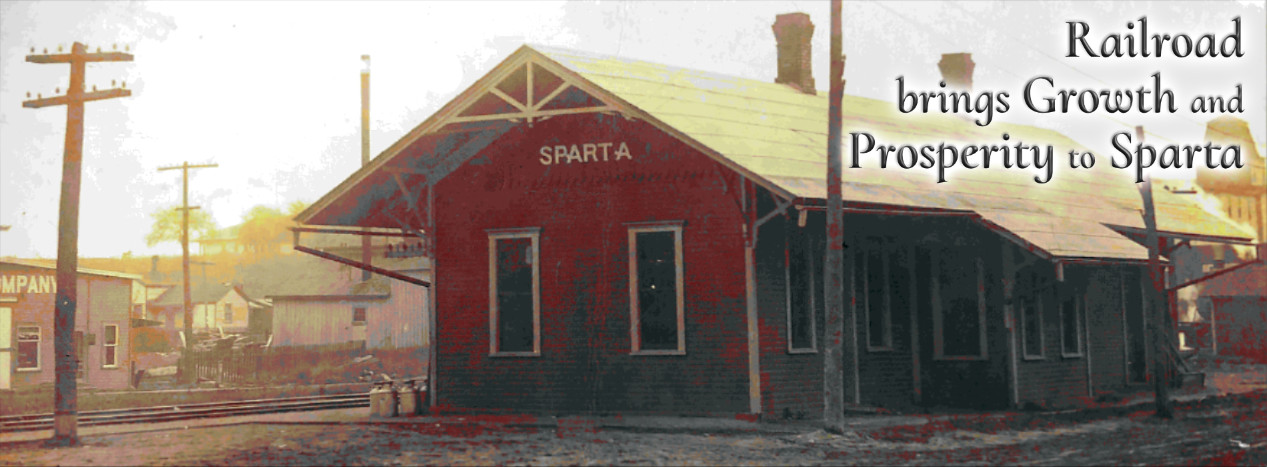

All Aboard!
Railroads pierced the wilderness of Kent County in 1858 when the first train chugged into Grand Rapids on the Detroit & Milwaukee. No longer isolated, others soon crisscrossed the county linking sleepy towns with the outside world. Just before Christmas 1867, the Grand Rapids & Indiana connected Cedar Springs and three years later completed the line south to Fort Wayne. Investment, development, industry, and opportunities sprung up along the steel rails.
Determined to see a railroad built to their town, Edwin A. Roby, a nurseryman and fruit farmer, along with Dr. Edmunds spoke at a meeting to explore public interest in a Grand Rapids & Muskegon Railroad. Roby and Edmunds were vocal about "pledging $10,000 in aid of the road if it shall go to Sparta Center," as was reported in a January 30th, 1869, article in the Detroit Free Press. Although it did not proceed, plans for another northern route were solidified on September 11th, 1869, when the Grand Rapids, Newaygo & Lake Shore Railroad Company was organized under the leadership of David P. Clay.
Grand Rapids, Newaygo
& Lake Shore
Skilled civil engineer, John Frederick Tinkham, along with men like his brother-in-law, Brigadier General William Power Innes, also a civil engineer who served with the 1st Regiment Michigan Engineers and Mechanics during the Civil War, and others determined the proposed route between Grand Rapids and Newaygo. Competition to secure the Grand Rapids to Newaygo railroad route through towns was fierce because it meant the difference between a bright future or what would surely lead to the village's demise. Eager to secure a railway at Sparta, local men, such as Edwin Bradford, became stockholders in the Grand Rapids, Newaygo & Lake Shore Company. Town fathers, farmers, and businessmen worked together to provide financial incentives and promises of manpower along with other enticements to close the deal with the railroad companies. Unfortunately, towns such as Lisbon in southwest Sparta Township, didn't fare well and virtually became ghost towns, almost overnight, while fortunate villages, such as Sparta, experienced boomtown growth.
With general routing decisions made, work to locate the line, secure right of way, obtain generous local financial and manpower aid, as well as other work necessary to get it built got underway. The Detroit Free Press published an account on July 11th, 1871, which stated: "The right of way for the Grand Rapids, Newaygo & Lake Shore Railroad has been obtained through Alpine, Sparta and other towns in Kent County."
On the 28th of April, 1872, the newspaper reported "Iron on the Newaygo Railroad is laid to the north of Sparta Center." Edwin A. Roby, a resident on the south side of Sparta, commemorated the event with an entry in his diary which read: "Locomotive came in sight today." By May 9th, the railroad to Sparta was completed. On September 11, twenty-two more miles of track were completed as the railroad was opened to Newaygo. Once steel rails connected Newaygo to Grand Rapids, it wasn't the end of the line for long. In short order, the backbreaking work resumed in May of 1875 as crews graded the route, laid ties, rails, and pounded spikes to extend the track north ten miles from Newaygo to Morgan to intersect with the east-west Muskegon & Big Rapids railway.
The train depot was built on the east side of downtown Sparta to the west of the rails and it fronted on Railroad Street, which was later renamed Elm Street. Eventually, the addition of a freight dock and stockyards were conveniently located south of the depot. Before long, manufacturing and other businesses sprung up in the general area adjoining the railroad.
R.L. Polk's 1877 State of Michigan Gazetteer & Business Directory described Sparta Center as:
- A village of 500 inhabitants, on the G.R.N.& L.S.R.R., in Sparta township, Kent county, 15 miles north of Grand Rapids. It has Free Will Baptist and Methodist churches, grist, saw and planing mills, and is a stirring business town. Wheat, lumber and stave bolts are the principal shipments. Settled about 1845. Telegraph, railroad line. Express, American. Mail daily. M.B. Nash, postmaster.
Stave bolts, by the way, were generally 39" sections of logs, usually white oak, which were used to make barrels or casks.
Edwin Bradford was listed as a grain dealer, W.I. Olmsted & Son had a saw and grist mill, and Vanwiltenburg & Anderson who owned a planing mill were among the first to take advantage of the Grand Rapids, Newaygo, & Lake Shore Railroad to ship their products.
True Confessions
Another in the series of letters to the Editor penned by H.M. Sleeper, a son of a Blacksmith tells of an adventure from his youth. At eighty-six years old, his recollection of this shenanigan was crisp. Although he thought it occurred in 1866, the first train didn't arrive at Sparta until 1872, when he was about twenty-three years old. Still a young man, the account is compelling, to say the least.
RECALLS ESCAPADE OF BOYS WITH R.R. HAND CAR
Sentinel-Leader Letter-box, 27 Jun 1935
Editor, The Sentinel-Leader:
"Have you heard of that wonderful one hose shay,
That was built in such a logical way."--Holmes.
Things change and a man is foolish to act as though they didn't. The early Pioneers of 100 years ago who invaded Sparta's forests, and conquered by force of will and muscle, and we are now enjoying the results.
To follow along down the growth of the village, every community has some little unpublished events that are not general but affect the lives of a few.
Boys are often thoughtless in their search for action.
As early as 1866, the railroad hand car was parked beside the track just east of the present school house grounds and in the edge of the woods by the clay road that runs east. The boys in their search for excitement thought that a ride on that car was necessary for their peace of mind. (Well they got it.) The car was securely chained. But one dark night they decided to try the unknown.
As there happened to be a blacksmith's son in the bunch, a hammer and cold chisel soon released the car. (None stopped to think of the seriousness of the job.) Record time was made down to Grand Rapids, but coming back, tired muscles, vanished ambition and the anticipated something they looked for that never came.
If you had asked those boys, do you believe in punishment before or after death, they would all have replied: Both.
But the car was replaced, a cold shut mended the broken link in the chain, and the boys went home. Two days later they heard from it.
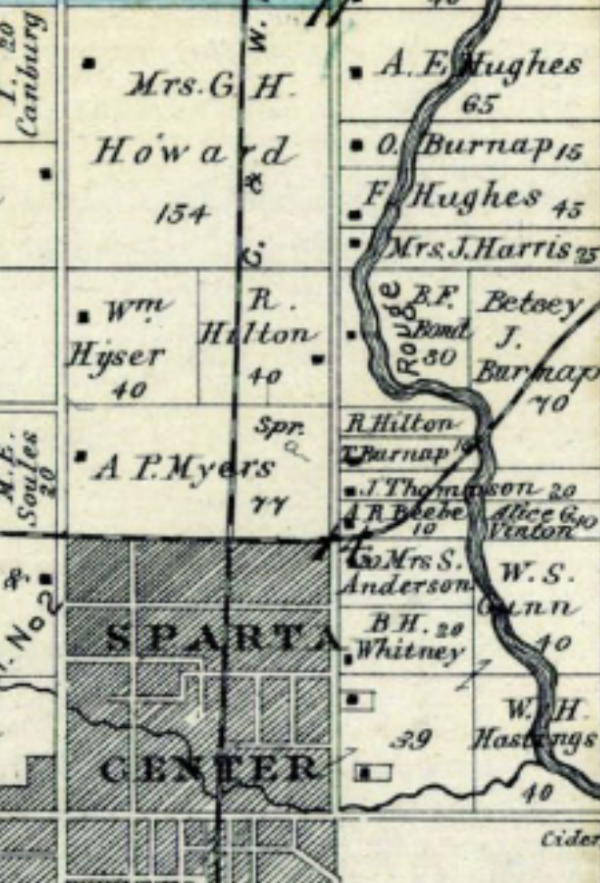
A portion of a Sparta Township plat map from 1896
But very fortunately for them, the president of the road, D.P. Clay was a personal friend of the Blacksmith, whose son was in the bunch, and their minister, E.W. Norton, and he was a personal friend to all.
The matter that might have been serious was settled with nothing more than a severe lecture to the boys, which I think they will never forget. But I don't believe remorse ever proved fatal to any of them.
But the river road also had its points of interest. East from the school grounds to the corner by the Nash Sugar Bush, and during sugar time that gate was swung open often. North by the little farms owned by Reynolds, Mrs Montgomery, John Anderson, Bromley, Burnap, Miller, Harris, Hughes, Munn, and Robert Hilton, stepson of Burnap.
On the Burnap farm was one of the finest springs in the country. A cave in the bank encased with a tight lining with shelves for Mrs Burnap's row of shining milk pans and cream jug and crock of butter, (not oleo) the floor clear white sand, that cold bubbling spring, to drink from it was a close rival to Woodworths, "Old Oaken Bucket". I am planning a pilgrimage to that spring again. I hope it did not become useless when repeal came in.
But don't class me with members of the Mecca Pilgrims who stop in the valley to stone the Devil, he has trouble enough now with the liquor regulation.
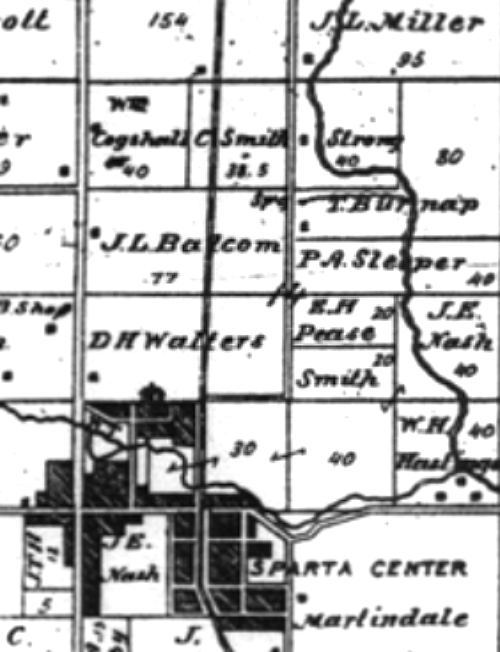
A Sparta Township plat map from 1876 identified the spring on the Burnap property
Did we visit that spring in haying time. I doubt if that much over-rated Ponce de Leon (The elixir of life) was much better.
H.M. Sleeper
Sleeper's Stomping Grounds
An 1876 plat map for Sparta Township reveals some interesting details. Henry Milton Sleeper's father, Peter, had eighty acres labeled "P.A. Sleeper" which stretched across from what is now Stebbins Ave through to Long Lake Drive, almost evenly divided by the Rogue River. It was situated about one mile north of East Division.
Jonathan Nash's sugar bush abutted the south east line of Sleeper's land.
Tracy Burnap was born in 1824 at Hornby in Steuben county New York. In 1870, he married Betsy J Hilton, a widow with two sons, Howard and Robert. She was the daughter of Zadock and Flavy Knapp. The newlyweds soon decided to follow her brothers: Sylvanus, Jared, and Erastus who were settled in Grand Rapids or nearby. Erastus came to the mitten state in 1847, Knapp Ave was named for him and he achieved status as a prominent businessman. By 1880, the Burnaps had arrived at Sparta, became next door neighbors to the Sleeper family, and were farming.
A spring was identified on the plat map which sprang forth on the Burnap homestead and ran about 1,000 feet east to the Rogue River.
I hope that Henry got the chance to visit his old stomping grounds and find the spring.
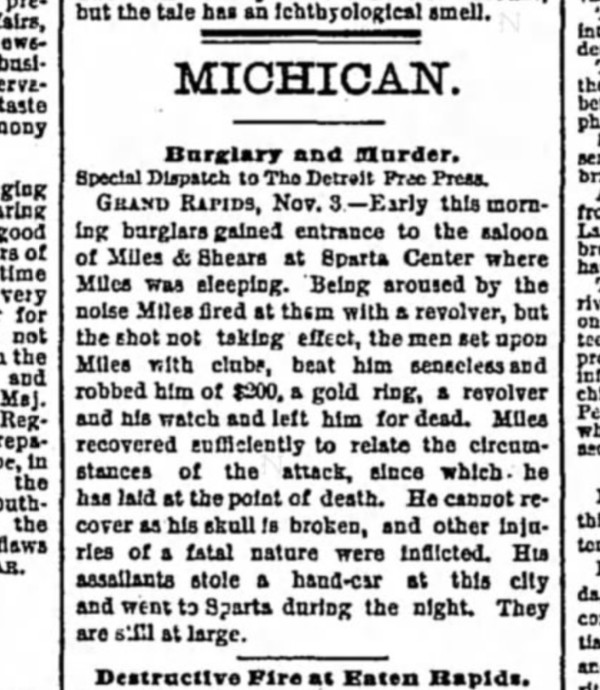
Detroit Free Press, 4 Nov 1887
Along with the growth and prosperity, sadly the train brought crime to the village.
MICHIGAN.
Burglary and Murder.
Special Dispatch to The Detroit Free Press.
GRAND RAPIDS, Nov 3 -- Early this morning burglars gained entrance to the saloon of Miles & Shears at Sparta Center where Miles was sleeping. Being aroused by the noise Miles fired at them with a revolver, but the shot not taking effect, the men set upon Miles with clubs, beat him senseless and robbed him of $200, a gold ring, a revolver and his watch and left him for dead. Miles recovered sufficiently to relate the circumstances of the attack, since which he has laid at the point of death. He cannot recover as his skull is broken, and other injuries of a fatal nature were inflicted. His assailants store a hand-car at this city and went to Sparta during the night. They are still at large.--published in the Detroit Free Press on 4 Nov 1877
Ten days later, the Pontiac Commercial confirmed the crime and published a few additional details: "A saloon keeper, named Miles, who has been in the habit of sleeping in his saloon, at Sparta Center, Kent county, was attacked by burglars on Friday night, who broke in his skull, and relieved him of $200 in money, and stole a gold ring off his finger. His injuries were supposed to have been fatal."
The unfortunate victim was David Allen Miles, a Canadian man of approximately sixty years. He and his wife, Mary Alice, migrated to Ohio and in 1842 their son, John David Miles, was born. Later, the family sought new opportunities in Michigan.
"Denison & Siples, billiards" was listed at Sparta Center in the 1875 R.L. Polk's Gazetteer. Several months later, in August, the duo made the news "...convicted by a jury and fined $75 for refusing to give the bonds required for liquor dealers," which was noted to be the first prosecution of its kind in Kent county. David Miles and Charles Shearer purchased the business and their saloon establishment appeared under Sparta Center as "Shearer & Miles, Saloon and Billiards." in the 1877 edition of C.F. Clark's Michigan State Gazetteer and Business Directory.
After his father's brutal murder, John took over the saloon as Charles, who had previously worked as a telegraph operator, found employment as a railroad clerk.
GRAND RAPIDS.
Special Dispatch to The Tribune.
GRAND RAPIDS, Mich., June 20.--The annual meeting of stockholders of the Grand Rapids, Newaygo & Lake Shore Railroad was held here to-day, and resulted in the election of J.W. Converse of Boston; Chester Warner of Chicago; D.P. Clay, L.H. Randall, E.P. Fuller, and William Sears of this city; W.D. Fuller and S.K. Riblett of Newaygo; and E. Bradford of Sparta. At a subsequent meeting of the Directors, D.P. Clay was re-elected President, L.H. Randall, Treasurer, and Chester Warner, Secretary and Superintendent. The affairs of the Company are in a very satisfactory condition.--published in the Chicago Tribune on 21 Jun 1878
Ed P. Fuller was a well-known philanthropist well respected for his benevolence in Grand Rapids. He and his wife were instrumental in the establishment Butterworth Hospital and its predecessor, St. Mark's Home and Hospital and other charitable endeavors. William Sears, Leonard H. Randall, and Edwin Bradford sat on the first board of directors of the Farmers' & Mechanics' Bank in Grand Rapids. David P. Clay and Leonard H. Randall were successful businessmen involved in the initial attempt to establish a Board of Trade.
Edwin Bradford
Born in Wayne County, Michigan in 1831, Edwin was a son of Moses and Elizabeth (Arnold) Bradford. The prominent family were among the early settlers of Sparta Township.
At the age of 24, Edwin decided to pursue business opportunities so he purchased 120 acres of land to resell and founded a mercantile business at Sparta Centre. Edwin was a member of the board of directors of the Grand Rapids, Newaygo & Lake Shore Railroad to represent Sparta's interests. Polk, Murphy & Co.'s 1874 business directory listed Edwin as the owner of a general store who also provided railroad and express agent services. In 1877, he appeared as a "grain dealer" at Sparta and by 1881, he had become very successful with daily sales topping $140, his land investments increased to include 440 acres in Kent County, 160 acres in Benzie County, and 80 acres in Missouri. In addition to a mill at Sparta, his holdings also included those at Casnovia, Grant, and a grist mill at Newaygo, along with numerous other properties in Sparta and Grand Rapids.
Chicago & West
Michigan
The Chicago & West Michigan Railroad Company announced their acquisition of the Chicago & Michigan Lake Shore, effective the first of January 1879. By December, newspaper headlines proclaimed "SALE OF PINE LANDS. The Largest Cash Transaction Ever Known in Michigan." Key stakeholders in the Chicago & Michigan Lake Shore in partnership with others from the Detroit, Lansing & Northern Railroad formed the West Michigan Lumber Company with George C. Kimball as President and closed on a purchase of 4,520 acres of "choice pine land" abutting their railroad on eastern Newaygo County. The land was estimated to cut 55,000,000 to 60,000,000 feet of lumber. Chief stockholders Nathaniel Thayer, George C. Merriam, Charles Francis Adams Jr., and other Boston investors also purchased the L.G. Mason sawmill at Muskegon. They cut out the middlemen to efficiently provide finished lumber delivered to the customer and supplied many of the area's major furniture manufacturers.
James Wheaton Converse
James W. Converse founded the Grand Rapids Stave Company in 1864 to produce barrels and sold out the business two years later. He and his Boston friends took the bonds and furnished funding for the Grand Rapids, Newaygo & Lake Shore Railroad's construction, then he became the controlling stockholder. Over the dozen years of operation, the unprofitable G.R.N.& L.S. railroad company had a net loss of $36,554.28. Early in January 1881, he sold his interests in this and the Grand Haven Railroads to Charles Francis Adams, Jr., who reorganized and consolidated them as the Chicago & West Michigan Railroad Company.
Notably, his other business ventures included the Converse Manufacturing Company, the Phoenix Furniture Company in Grand Rapids, and he served as president of a Boston bank. In 1883, Mr. Converse funded the construction and furnished the Second Baptist Church in Grand Rapids.
CHICAGO & WEST MICHIGAN.
Special Dispatch to The Chicago Tribune.
GRAND RAPIDS, Mich., Jan. 22.--The Chicago & West Michigan Railroad Company substantially concluded the details and contract to-day for the purchase of the Grand Haven Railroad, a line of fifty seven miles long, from Muskegon to Allegan, and the Grand Rapids, Newaygo & Lake Shore Railroad, from this city to White Cloud; forty-six miles long. At White Cloud the Newaygo Road has a junction with the Muskegon & Big Rapids branch of the Chicago & West Michigan. The details of the price paid are not reported yet. The two roads in stock and bonds represent a little more than $3,000,000. It is probable that the Chicago & West Michigan meets them by buying a majority of their stock. The roads are to be turned over at once as soon as the final papers are signed, and probably will be managed as divisions of the main line. They will prove valuable feeders and much more useful to this city as part of a system than as small independent lines. It is supposed too, that the Newaygo Road will soon be extended northwest, perhaps to Manistee, a matter of much moment to business interests here. The people of this section are glad of the purchase, and the announcement of its consummation is hailed with great satisfaction.--published 24 Jan 1881
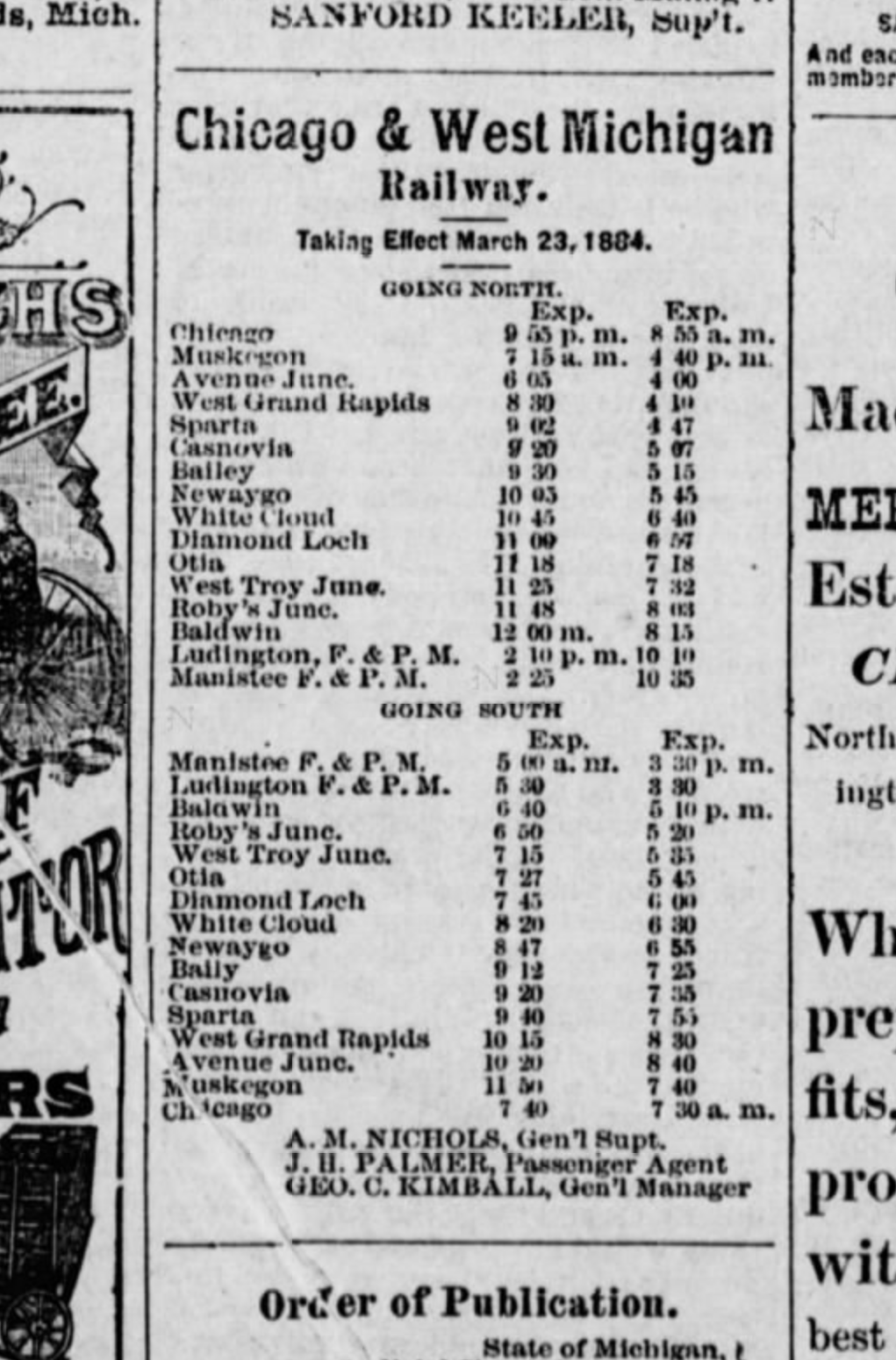
The 1884 railroad schedule
On February 3, 1881, a shareholders meeting was held at the company office in Grand Rapids where it was announced the Chicago & West Michigan Railroad Company purchased both the Grand Haven and the Grand Rapids, Newaygo & Lake Shore Railroads, on January 26th and had taken control immediately. An article published in the Pentwater News stated the two Michigan railroads included 100 miles of track at a cost in excess of an astounding $8 million dollars to construct. By July, the Chicago & West Michigan added the Indiana & Michigan Railroad Company.
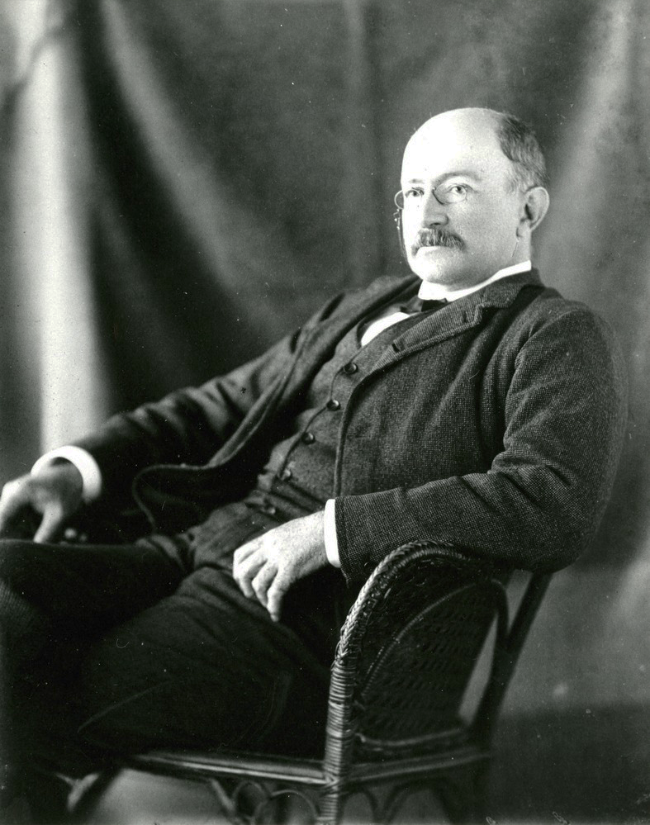
John Quincy Adams II, photograph courtesy of the Adams National Historic Park, National Parks System
The Muskegon News and Reporter wrote in November 1881: "The pressure on the Muskegon Car Works is so great at present that they are unable to fill the orders for cars, and have had to cancel several large orders. This has been done partly on account of the Chicago & West Michigan Railroad requiring 200 cars at once to supply local demands, which far exceed the supply. This speaks well for Muskegon as a manufacturing center. The car works will soon find it necessary to build new shops, so that they can duplicate their present capacity."
The Chicago & West Michigan was managed by George C. Kimball, and primarily owned by John Quincy Adams II, his brother, Charles Francis Adams, Jr., Nathaniel Thayer, and their associates in Boston, Massachusetts. Once under the control and ownership of Chicago & West Michigan, it was full steam ahead as it was announced they would add 349 miles to the lines. Mr. Kimball, who resided at Muskegon and formerly of Grand Rapids, was elevated to the roles of company Vice President, General Manager, and a member of the Board of Directors.
No longer isolated or having limited access to other towns, Sparta had two north bound and two south bound train stops each day, as the train schedule dated March 23, 1884, indicated. The Chicago & West Michigan operated its route 24 hours a day. Travelers and shippers had access to fifteen Michigan locations in addition to Chicago, and daily mail service.
Little Nickolai Girl
Wanders onto Train Tracks
America beckoned and the Jost Nikolai family left their home at Treis an der Lumda, Giessen, Hesse, Germany, a small village about fifty miles north of Frankfurt. His sister, Margaret, had already made the journey a year earlier onboard the steamship Frisia, just a few months after their father, Johann Heinrich Nikolai’s death. Their mother, Anna Catharine (Lemp) Nicolai, and younger siblings, George and Katherine, would soon follow.
Jost and his expectant wife, Christina (Opper) Nickolai, along with their two children, Elizabeth at three years of age and Conrad a year younger, set sail on 8 Oct 1880 from Hamburg, Germany, onboard H.J. Perlbach & Co.’s steamship the Hamburg with a stop at Liverpool, England, prior to their arrival at New York. The young family travelled “ohne angabe” - when translated meant "without accommodations" - as was noted on the passenger list, which made a difficult journey all the more challenging. Once the Nikolai family disembarked, they made their way cross-country and arrived at Algoma Township in Kent County, Michigan, in time for their daughter Mary’s birth on the 11th of January. Two years later, on 20 Jan 1883, the Nickolai family welcomed the birth of Anna Kathryn.
Why would the Nickolai family travel so far to settle at Sparta?
Aside from the political and religious persecutions which brought millions of German immigrants to our shores in search of a better life with new opportunities during this time frame, the family matriarch, Anna Catharine’s younger brothers, Adam and John Lemp, had already made the trip in 1857 and 1854, respectively. By 1860, the Lemp's found themselves at Algoma township in Kent County, Michigan, where Adam purchased a tract of land in Section 17 and established a farm. A couple of years later John moved on to Iowa.
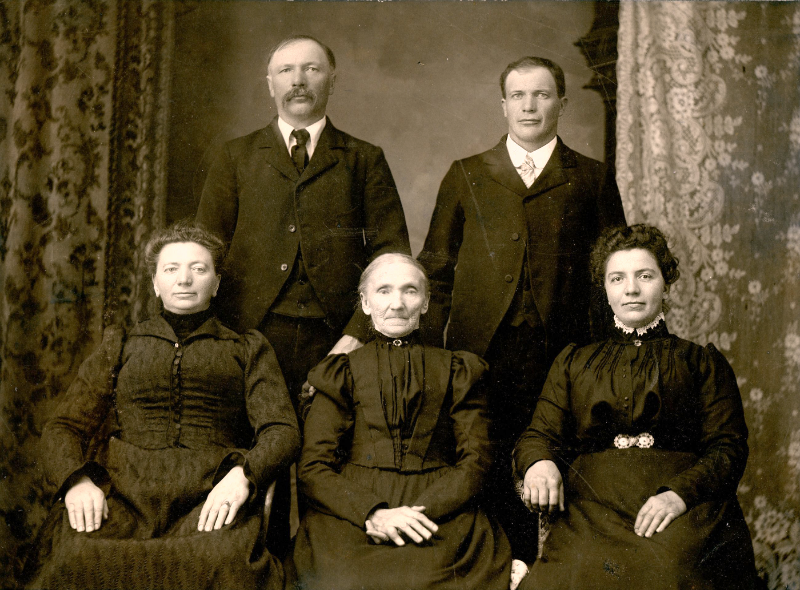
left to right: Margaret (Nickolai) Kimball DeLange Finnucan, Jost Nickolai, Anna Catherine (Lemp) Nickolai, George Nickolai, and Katherine (Nickolai) Nash, about 1900, family portrait courtesy of Karl Nickolai
Naturally, when twenty-two year old Margaret came to America, her destination was Uncle Adam’s home at Algoma Township. She later wed William Orlow Kimball, a farmer from Cedar Springs, on 16 Feb 1883 in a ceremony performed by W. Heald, "Minister of the Gospel", which was witnessed by "Yost Nickolai and Adam Lemp, both of Algoma", as was the bride. The brief union produced a son, William, before the couple went their separate ways. On 10 Feb 1887, Margaret and John DeLange, a Dutch harness maker, were married at Sparta and the couple had a son, Henry. Widowed, Margaret wed Cornelius Finnucan on 12 Jan 1898, at Sparta. The groom was a New York born "traveling salesman" and the bride gave her occupation as a "merchant" as she continued to operate the harness shop, with great success.
In early 1884, Jost relocated his family into a newly built rural home on a six acre parcel of land three miles north of Sparta Center. The irregularly shaped property was a triangle corner divided by the railroad from the whole of J.H. Kecher's land along with a narrow panhandle strip. The Nickolai home fronted on what would later become 16 Mile Road, however, the structure was demolished and paved over before 1920 when Ball Creek Road was built along the west side of the railroad.
On the first day of June in 1884 the Michigan Census placed Jost and Christina’s family at Sparta Township along with their children, "Lizza" (Elizabeth) and Conrad, plus daughters born since their arrival in Michigan: three year old Mary and Anna at one year. Grandma Anna, lived in the household where she “cares for children” while Jost was a "stone mason", a family profession shared with both his brother, George, and their late father. Jost's skill earned him a stellar reputation in his trade as he expertly cut the stones for many homes, businesses, and public buildings in Sparta and the surrounding area. Stones utilized in the construction of the Sparta State Bank and in the oldest part of the Sparta High School were masterfully hand cut by Jost Nickolai.
Mid-July was a busy time in the countryside tending animals, collecting eggs, picking raspberries, and weeding the garden as all able-bodied hands helped with the chores while younger children played nearby. It was not uncommon for folks to walk down the railroad tracks, whether to visit neighbors, go into town, or just for relaxation, especially those whose homes were close-by, such as the Nicolai family.
Accustomed to the rhythmic sound of the massive locomotive and rail cars as they chugged over the steel tracks right behind the house, vibrated windows, rattled items on shelves or tucked inside cupboards. People might glance in the direction of the passing train but would generally continue about their daily activities without as much as a second thought. The familiar schedule of the trains' passing soon became something by which a person could set their clock. Only when the train was late or in the case of some other unusual event did people take notice. July 16th, 1884, was such a day.
Somehow the Nickolai toddler had managed to wander from her backyard and climbed onto the train tracks, unnoticed, then she followed it southeast for some distance until the lost child became tired, laid down, and fell asleep.
At right before 9:30 in the morning, the southbound train swiftly approached the Ball Creek bend just past the Nickolai's home, when suddenly the train screeched to an abrupt halt. Shouts and agonizing screams brought all within earshot to the scene.
The Saginaw News published a brief item on 19 July 1884 concerning a tragic accident which occurred just north of Sparta:
- Train No. 52 on the Chicago & West Michigan railroad run over a little girl named Nickoli at Ball Creek Thursday, cutting off one arm. The child was alone and over a half a mile from home.
On the same day, an account was published in the Detroit Free Press under the heading of "MICHIGAN. General Items." which expanded on the details of the incident:
- A sad accident occurred near Ball Creek, on the Newaygo division of the Chicago & West Michigan Railroad. A freight train was rounding the curve at that point, when the engineer saw a little girl lying asleep on the track, just inside the rail. The train was going rapidly and there was no opportunity to stop, and the wheels passed over the child's right arm, severing it at the wrist. The child's head was also severely injured, a slight fracture but no indentation being sustained. The child was taken to Sparta, and the latest news was that it could possibly survive.-Grand Rapids Leader.
Five days later on July 24, the Lake County Star reported on the accident near Sparta:
- A little girl, named Nicolay, between two and three years old, was discovered asleep on the track of the C.& W.M.R.R., near Sparta, Wednesday of last week, just as the passenger train from the north rounded a curve. The engineer reversed the engine as soon as possible; but too late to avoid accident. The right arm was cut off at the wrist, and her head was cut; but it is thought she would live.
In addition to company financial reports, death and accident details were included in the Michigan Railroad Commission's Annual Report. The published data for the Chicago & West Michigan Railroad included among the "Injured" a simple sentence: "July 16. _____ Nickle (child), two and a half miles south of Kent City, trespasser; arm taken off."
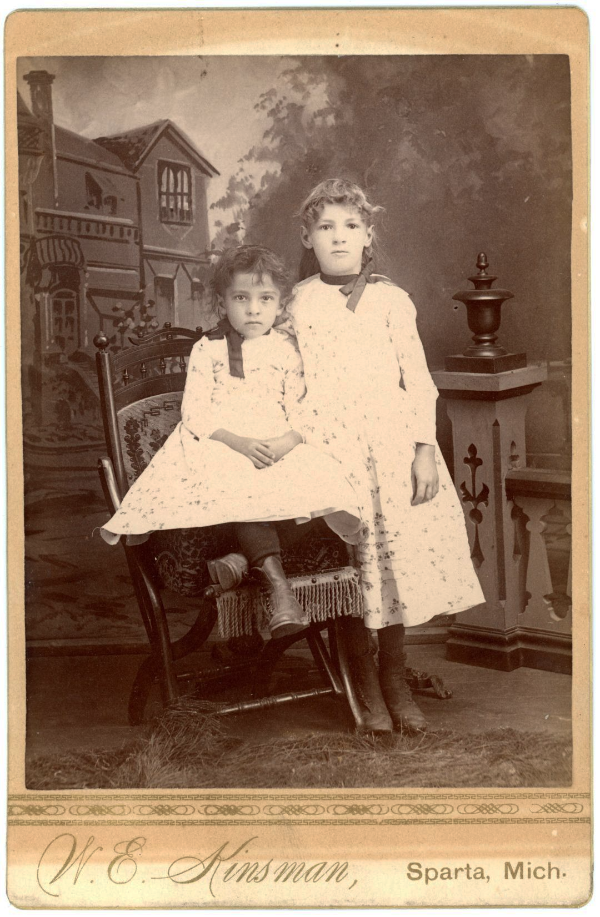
left to right: Bessie and Anna Kathryn Nickolai, about 1890, portrait by W.E. Kinsman, courtesy of Karl Nickolai
Astonishingly, it was nothing short of a miracle for the little girl to survive her horrifying brush with death. At the time, Sparta had three physicians: Benjamin F. Babcock, Charles E, Patterson, and Daniel J. Wallace. Prayer, quick action in getting the child to the doctor, and one of these three men undoubtedly saved the child's life.
Furthermore, we know she survived into adulthood as the 1900 US Census asked women how many children they had and the number still alive. Christina Nickolai indicated five on both questions. The newspaper account suggested the victim was "between two and three years old", which could have been either Mary or Anna who suffered the severe injury.
In this case, research, records, and news items only go so far in telling the story, so I reached out to Karl Nickolai, who graciously provided additional research, family portraits, and located family members with first-hand information:
-
Barbara (Atkinson) ruled out her grandmother Mary Nickolai as having any injury sustained in a train accident like that described in the newspaper articles. She remembered her grandmother's sister Anna, but did not recall her having such an injury either. However, Barbara then contacted her brother and sister who both remembered "Aunt Annie" as missing part of her right arm. Barbara's brother has a memory of attending a family dinner at their grandmother Mary's house many many years ago which "Aunt Annie" also attended. He noticed the injury to her right arm while she was holding a big mixing bowl and watched as she was mixing and twirling the contents of the bowl with a spoon. Barbara's brother described the injury he observed as the loss of her right arm below the elbow. He later asked his father about it. His father told him that "Aunt Annie" was hit by a train when she was a child.
Indeed, eighteen month-old Anna Nickolai was that little girl!
Life goes on and the seasons change. With Spring's arrival, Jost and Christina were blessed with another daughter whom they named Bessie.
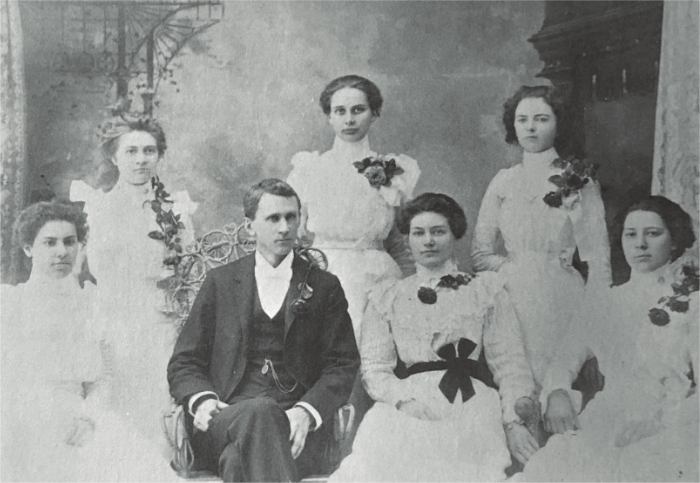
left to right, back row: Bessie Hicks, Alice Walcott, unknown; front row: Claribel Ewing, Supt. L.L. Coates, Ada Fuller, and Ina Loop. Sparta Class of 1900. Was Anna Nickolai the "unknown" girl?
At the time of the 1900 Federal Census' enumeration, Anna and Bessie attended school and lived at home with their parents. Jost continued to work as a stone mason and paid a mortgage on their home. Mary had wed James Albert Atkinson earlier that year on the third of January. Conrad entered the brick maker's trade, married Lorinda Longcore, and remained in the Sparta area. In 1898, Elizabeth became the wife of Ernest L. Perkins and soon celebrated the birth of their daughter, Florence. The Perkins lived in town and he also worked at the brickyard for a number of years before the family purchased a home at 233 North Union (which was later renumbered to be 275 North Union) and Ernest took a job as janitor at the high school. Jost was widowed in 1904 and shortly thereafter, he sold the family home to a Mr. Carlson and moved in with his daughter Elizabeth and her family. Bessie never married. After a career as an administrative secretary, she purchased a home at 77 Alma Street and returned to her hometown.
The sisters, Anna and Bessie, were good students and graduated from Sparta High School. Anna may have been the "unknown" girl in the Class of 1900 portrait. The resemblance is strong and the pose which carefully concealed the lower portion of her right arm tightly bent behind her back was consistent with Anna's injury. Her age at the time fit in well with those of her classmates.
Anna accepted a teaching position at the Algoma District 8 schoolhouse, more commonly known as Morningstar school, a position she held during the 1903 county school census. Anna's occupation was recorded as a "schoolteacher" at the time of her marriage on April 8th, 1905, to Frank S. Chamberlain, a Middleville farmer. The newlyweds relocated to Grand Rapids where Frank was employed in a furniture factory and later became a millwright at a hardware factory. Frank and Anna's marriage was blessed with two children: Russell and Francis. The family lived on Leonard Street in 1915 when their ten year old son sadly died of Diptheria. The Chamberlains remained in Grand Rapids, and Anna frequently visited family at Sparta.
MUSKEGON, MICH.
Aug. 19.--The West Michigan Lumber Company, of this city, had $20,000 worth of lumber burned Woodville this morning, on the C. and W.M. Railroad. Kinney's mill and other buildings at the same place were also destroyed. Loss, $25,000: insurance, $15,000. The West Michigan Lumber Company had $18,050 insurance on lumber.--published 20 Aug 1884 by The Inter Ocean at Chicago, Illinois
The West Michigan Lumber Company announced the gradual end of their operations via a 31 Jan 1891 item printed in the Boston Post with dividends and cash payments for investors. The Buffalo Evening News ran a story on April 15th, 1893 about the destruction of the company's lumber yards at Diamond Lake, Michigan, in a fire caused by a spark from an engine. The loss included seven million feet of lumber, half a million bundles each of shingles and lath, and ten freight cars.
John Quincy Adams II
and Charles Francis Adams, Jr.
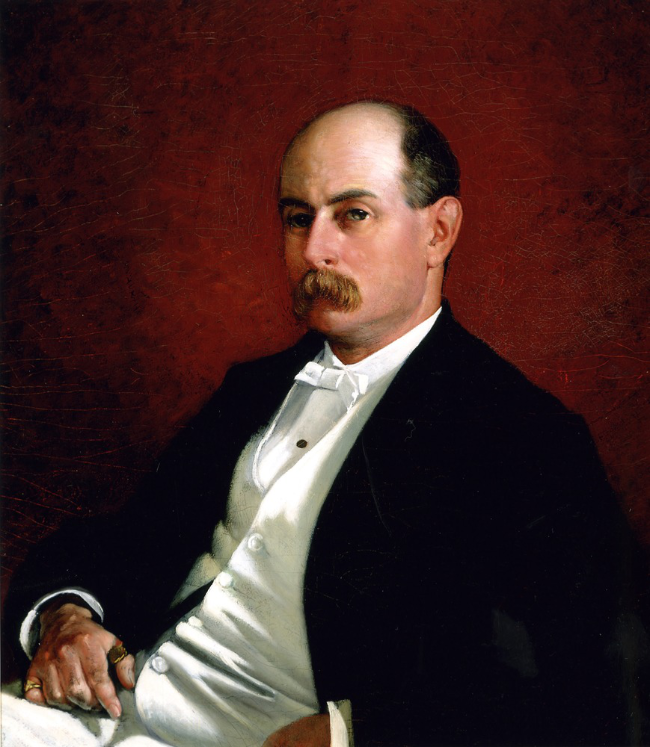
Charles Francis Adams Jr., 1876 portrait by C. Millet, courtesy of the Adams National Historic Park, National Parks System
The Adams brothers were grandsons of President John Quincy Adams, and great-grandson of founding father and our second President, John Adams. Not that they weren't already wealthy, the brothers sought to make a name for themselves other than riding on the coattails of political greatness forged by their ancestors. Eager to become affluent railroad magnates and lumber barons, they formed a Boston Corporation consisting of well-heeled friends from successful pre-Colonial families, many of which had also served as officers during the Civil War, and who were like-minded investors. Among their fellow capitalists were Nathaniel Thayer, Francis Winthrop Palfrey, John A. Burnham, Sidney Bartlett, and Charles Merriam.
Charles F. Adams, Jr. was a Harvard educated lawyer who served as a Brigadier General during the Civil War. He possessed a keen interest in railroads and was appointed to serve on the Massachusetts Railroad Board. From 1884-1890, he was appointed by the government to be the president of the Union Pacific Railroad, a position he resigned due to what he described as a conflict of interest: on the government payroll, yet bound by duty to represent the best interests of the railroad when he may be called on to testify against them.
As a writer and speaker on a broad range of topics which included his famous family, politics, railroads, and education, he was well known to express his views with eloquence and honesty. In his later years, shortly before his death in 1915, he reflected on his foray into Michigan railroads and lumber in his autobiography:
- On the other hand, looking back, I wonder at my own lack of insight and foresight. It seems to have required a certain degree of skill on my part to escape the opportunities, the great opportunities, fortune flung in my way; as also a certain perverseness seems to have been necessary to cause me to wallow, as it were, into the misadventures in which from time to time involved myself. For instance, a participation in the great success of the Calumet and Hecla(?) -- the bonanza mine on record -- was in 1868 almost thrust upon me; but I preferred to "invest" in some wretched Michigan lumber railroads, which I long ago dropped as hopeless. None the less, however, I did get through; and got through better than I had any right to expect -- indeed, successfully, as success in such things goes. That, in place of my suffering financial shipwreck, it so fell out was the result partly of persistence, partly of judgement, largely of luck.
Were it not for these East Coast men of status, means, and deep pockets who were willing to risk it all on a roll of the dice as they invested millions to build railroads in pursuit of the lumbermen's axe, Michigan surely would not have developed as quickly as it did to provide abundant opportunities for homesteaders, farmers, merchants, entrepreneurs, and industrialists... and Sparta may not have become the village we know today.
George Caleb Kimball
Born in 1829 at Dover, New Hampshire, he was the son of Abel and Dolly (Spofford) Kimball. George married Azubah S. Fairbrother in 1855 at Dover, Strafford, New Hampshire. He was the Superintendent of the Cochecho Railroad at Dover in 1851-1865 and in 1871, George moved westward to become the Superintendent of the Flint & Pere Marquette Railroad based at Saginaw, Michigan.
Kimball & Co., listed in the 1877 Michigan State Gazetteer and Business Directory, was owned by George C. Kimball, a master machinist and proprietor of the Genesee Iron Works at Flint. They were "Manufacturers of all kinds of malleable iron, grey iron and composition castings, steam engines, finishing, Japanning and general job work done to order." Mr. Kimball was also the "receiver and general manager of the Chicago & Michigan Lake Shore RR."
John D. Miles
In the 1880 Federal Census enumeration, John D. Miles was unmarried and stated his occupation as a "saloon keeper". He boarded in the home of a fellow Sparta businessman, Porter Alan Vinton, who owned the newly built grain elevator. At sixty-one years of age, the miller from Syracuse, New York, along with his twenty-nine year old wife, Amanda Mattie V. (Bowen) Vinton, and two sons by a previous marriage completed the household. Walter Vinton, twenty-one years old, worked as a miller with his father and the younger son, William, at seventeen, was an apprentice to become a train engineer.
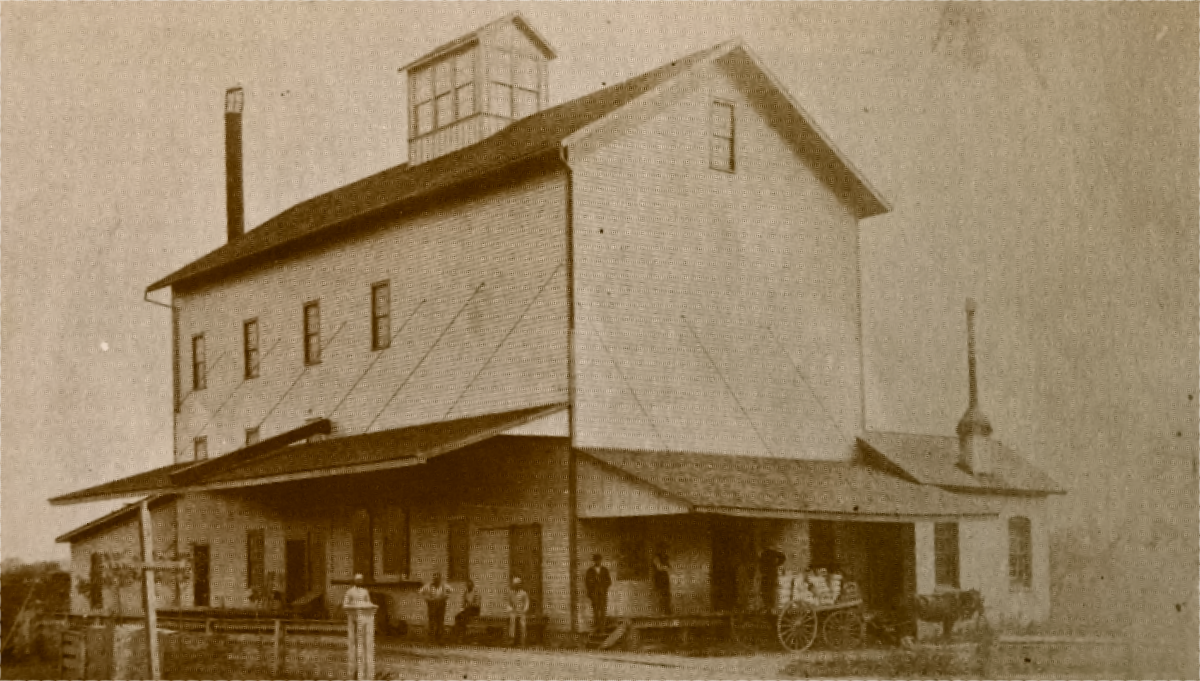
Sparta's first feed mill built in 1878 by Porter Vinton and sold in 1882. Photographed in the late 1800s.
Half-way between Sparta and Grand Rapids, Porter Vinton owned and operated a flouring mill in 1875 at Alpine Station on Mill Creek where it crossed what is now Vinton Avenue. Alpine Station was a small settlement of 400 where the train stopped at the modern day intersection of Seven Mile Road and Vinton Avenue in Alpine township. Vinton's Mill was a business in which Porter had over 110 customers, as recorded in his ledger.
According to his biographical sketch included in the 1881 History of Kent County, Michigan published by Chas. C. Chapman & Co., "He owns a farm of 90 acres, near Alpine Station, and built the first grist-mill at Sparta Center, in 1880. It is worth about $6,000, and was in complete running order in two and one-half months from the time it was begun. It has two run of stones." Elsewhere in the same book Mr. Vinton is credited as starting the first flour mill at Sparta in 1878.
R.L. Polk & Co.'s 1882 directory included a listing for John D. Miles, who still operated a "billiard hall" at Sparta Centre. However, a growing segment of the local population did not approve of this type of business in their town. It was targeted by the local branch of the Women's Christian Temperance Union (WCTU) as they circulated petitions against the "billiard hall and gambling den" per the Kent County Corresponding Secretary, Mrs. Eliza Mark's report. Other local women actively involved in the group and who sought change in their community included: Superintendent Mrs. L.P. Humphrey, Mrs. Lottie Coburn, Mrs. Libbie Ballard, Mrs. Lucina Ballard, Mrs. Genie Cheney, Mrs. Zula Holmes, Mrs. Hattie Crain, Mrs. Libbie Field, Mrs. Lillian Pease, Mrs. M.N. Burch, Mrs. Flora Warner, Miss Genie Van Wiltenberg, Miss Emma Symes, Miss Lulu Symes, and Miss Leta Wheeler. Perhaps a direct result of the women's efforts, Mr. Miles and his business did not appear in subsequent records or business directories.
Endeavors on the part of the village to attract industry leaked to the press and was widely reported throughout the state: "A $50,000 furniture factory is talked of at Sparta Center, Kent county," according to September 1882 editions of the Milford Times, Isabella County Enterprise, Lake County Star, and Evart Review, to name a few.
Determined to pull the welcome mat out from underneath anyone intending to operate a saloon, "The village council of Sparta, Kent county, positively refuses to approve the bonds of any saloonist," the Lake County Star reported on 21 Feb 1884. The applicants were saloon keepers Christopher and Philip Post of Plainfield who planned to open a liquor business in Sparta. Upon the village's refusal to accept their bond, they sued and appealed to the Michigan State Supreme Court, which viewed it as a test case. In the October 1885 verdict covered by the Grand Rapids Eagle, Sparta prevailed on the grounds of an 1883 law which empowered villages organized under the general law to "suppress saloons".
Pere Marquette
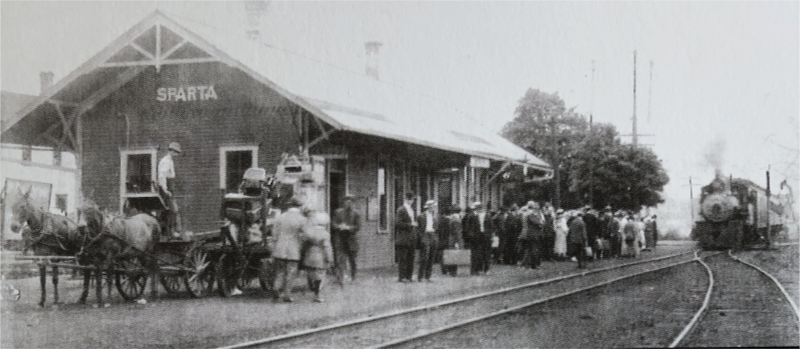
Awaiting the Pere Marquette train at the Sparta depot in the early 1900s.
Originally, the Flint & Pere Marquette Railway was chartered on January 22, 1857, by George M. Dewey and E.H. Hazelton to establish a railroad from Flint, west across the state to Pere Marquette, which is now known as Ludington. In 1868, control passed to Michigan Governor Henry H. Crapo and his son, William. By mergers, consolidations, and the hard labor of forging track through Michigan's forests, the goal of reaching Ludington was finally realized on December 1, 1874, for a total distance of 253 miles.
With $1.2 million in debt in 1879, the Flint & Pere Marquette went into receivership, but reorganized and pressed onward. Railroads had relied upon lumber, which made up 80% of their cargo tonnage, but by 1877, the transport of logs declined as the lumber era began to come to a close and slowly, train cargo freight began to shift as agriculture and industry took hold in the region. Many unprofitable railroad companies were unable to repay their bondholders. Often, it became a case of sell or face mortgage foreclosure action. The Flint & Pere Marquette purchased many smaller companies for pennies on the dollar. The Flint & Pere Marquette merged with the Chicago & West Michigan Railroad as well as the Detroit, Grand Rapids & Western Railroad under the newly incorporated Pere Marquette Railroad effective January 1st of 1900. The company was headed by President Charles M. Heald and William W. Crapo was chairman of the board.
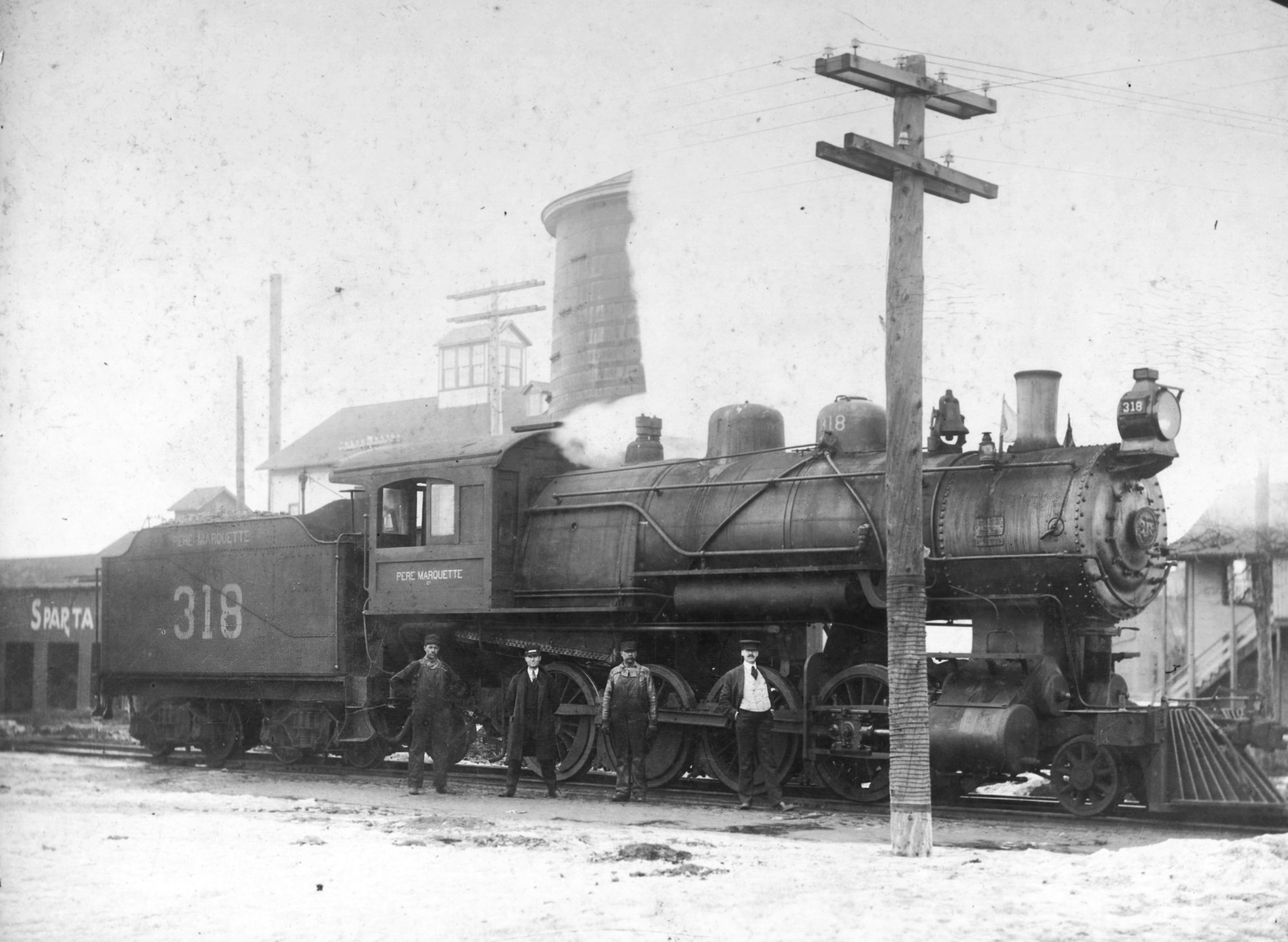
Pere Marquette engine 318 at Sparta
The Pere Marquette was better positioned to weather the transition from the days of lumber trains to the modern era, due in part the advantage of their ferry boats used on Lake Michigan, Lake Erie, the Detroit and St Clair Rivers which transported entire railroad cars.
Another Tragic Accident
Unfortunately, some people misjudged the power and speed of a train and, as a result, suffered severe consequences. "Jumping from a train at Sparta, Allie Covert, a telegraph student, fell and crushed his forehead. Chances for recovery about even," the Newberry News included the item on March 1st, 1895, in their "Michigan Happenings" column.
The 1888 city directory placed Allie employed as a clerk at Lowell. Just below Allie's listing was Andrew J Covert, a laborer who worked at the Welch Folding Bed Company in Sparta. Allie, whose given name was Allen, was the younger son of Andrew and Ella (Maddox) Covert. The family lived at Sparta since before 1880, when Allen was three years old. Sadly, Allie's accident proved fatal as the eighteen year old died on 25 Feb 1895 and was buried at Sparta's Greenwood Cemetery.
Toledo, Saginaw
& Muskegon
The Cleveland Plain Dealer and The Cleveland Leader broke the news of the formation of the Toledo, Saginaw & Muskegon Railway Company on January 21, 1886, when "Capitalists from Michigan towns and this city met here today." A new means to travel east to west would begin at Ashley in Gratiot county Michigan, the northern terminus of the Toledo, Ann Arbor & Northern Michigan. The new railroad--or just "road" as it was often called--would run to Saginaw and west to Muskegon as it was planned to stretch over 125 miles. Other reports estimated the length to be as high as 140 or 150 miles when completed.
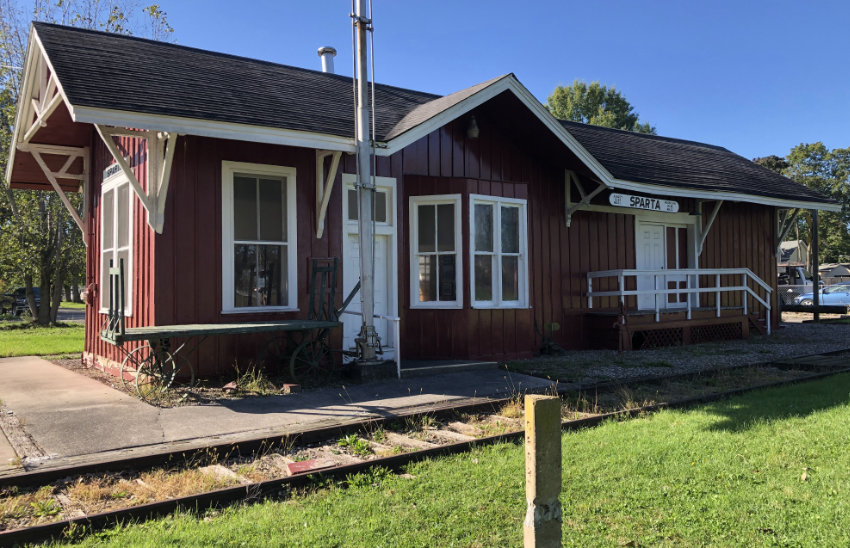
The little depot built in 1888 by the Toledo, Saginaw & Muskegon--photo by Loretta Baughan
News of the project traveled fast and was published as far away as in the Kansas City Journal which stated the track would go through Montcalm and Kent counties. At the time of the announcement, the planned route already included Greenville but it would be the surveyors' feasibility determination coupled with the willingness of towns, villages--and citizens--to participate in the process and invest capital in the project that would effect the final design.
Interested parties met again on the 23rd and "...decided to capitalize the company at $2,800,000. They proposed to push the work without delay," said an item that appeared in The Saginaw News. Wasting no time, crews of surveyors set to work. On February tenth, The Muskegon Chronicle noted the names of several surveyors who were registered at the American House hotel: J.C. Abbott, manager, Clifford S. Gamble, Walter Boyd, Harry Fitzimmons, C.H. Converse, Sam Torrence, and Joe Bowers.
Further specifics were published in early March as it was emphasized the company "requires the people along the line to raise $2,000 a mile and give the right of way," The Times Herald of Port Huron reported. To put this in perspective, that $2,000 in 1886 is equivalent to $68,396.81 today (2025). It was common knowledge that communities with railroad stops grew and prospered, so many along the proposed routes eagerly competed to demonstrate their interest and support by a willingness to meet these requirements.
Muskegon & Saginaw Railroad.
A large and enthusiastic railroad meeting was held at Sparta Wednesday in the interests of the Toledo, Saginaw & Muskegon railroad, which is to run from Ashley to Greenville and from the latter point through Sparta to Muskegon. The meeting was attended by L.G. Mason, of Muskegon; E. Middleton, of Greenville; and Elliott T. Slocum, of Detroit. Engineer Smith, of the new line, was also present. Mr. Slocum owns 5,000 acres of land at Slocum's Grove, between Sparta and Muskegon on the proposed line. A committee to solicit funds and secure right-of-way was appointed.--The Muskegon Chronicle (26 Nov 1886)
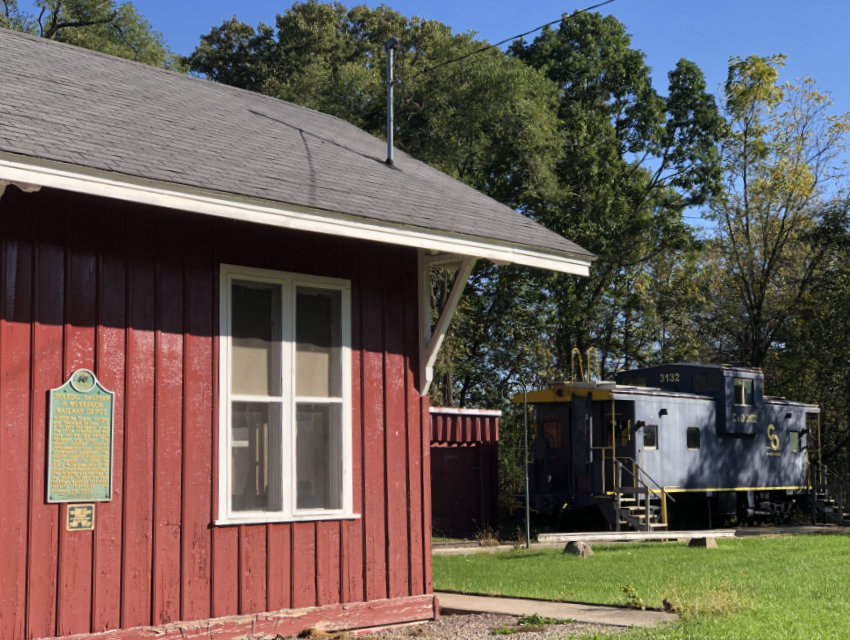
Sparta's last remaining depot, its historical marker, and a caboose--photo by Loretta Baughan
The idea of a second railway through Sparta cultivated excitement. The prospect of the village being at the crossroads of two significant railroads held the promise of economic and personal benefits to the residents and the forward-looking community. "The Spartans are aroused to a contributing point over the prospects of the new Toledo, Saginaw & Muskegon railroad passing through their town on the way to Muskegon." the Grand Rapids Weekly Leader observed on the first of December. "They will subscribe liberally to encourage the enterprise."
Just before Christmas, there were two proposed routes--one of which included Sparta. Muskegon had raised its quota of $50,000 and provided terminus facilities. Another $50,000 was needed between there and Greenville, a distance of fifty-one miles.
Friendly competition became "considerable strife" between Cedar Springs and Rockford as well as between Sparta and Bailey as to the question of exactly where the new route would cross existing north to south railroads. By February 3rd of 1887, two additional surveys were completed. "On Monday Sparta voted to bond the town for $10,000." it was reported on the tenth in the Muskegon Weekly Chronicle and "The contractors are now pushing the work on the route east from Greenville, employing from 500 to 1,000 men." A report in the Grand Rapids Democrat stated "The business men at Sparta are willing to do their share and if every point along the line is as enthusiastic it will not be long before contracts are let and work commenced."
The suspense ended when on March 25th, the Detroit Free Press noted the route through Cedar Springs and Sparta had been selected--with Cedar Springs "rejoicing over having won a victory over Rockford." According to a May 9th article in The Grand Rapids Press, a contract was "awarded Fullmer & Kitchen, of this city, to construct six miles of the Toledo, Saginaw & Muskegon railroad from Sparta westward, and they will commence the work tomorrow."
In November, "The last rail of the Toledo, Saginaw & Muskegon railroad was laid on the 30th just east of Sparta and through trains will be running on the line by Dec 20," penned The Ann Arbor Democrat. Final preparations for the big day were underway to install telegraph lines when the unthinkable happened.
A MAN KILLED.
A TERRIBLE ACCIDENT ON THE T.,S.& M.RY.
William Webster Falls Backward Off a Car His Head Cut Off by the Wheels.
William Webster, aged about twenty years, was instantly killed on the Toledo, Saginaw & Muskegon Railway, a few miles west of Sparta, yesterday afternoon. Webster and other workmen were on a train distributing telegraph poles along the line, the train running along slowly. Webster stood on the end of one of the flat cars, and was in the act of lifting a pole when he lost his balance, and fell over backward between the cars. The wheels passed over him, severing the head from his body and terribly mutilating his body. The train was quickly stopped and Webster's remains brought here last night. Coroner VanderWerp selected a jury and after hearing the testimony of witnesses of the awful affair the following verdict was agreed upon: That William Webster came to his death on the 19th day of December 1887, four miles west of Sparta Centre on the line of the T.S.& M. Ry. by accidentally stepping off from the rear end of the car on which he was working while in the act of unloading telegraph poles that were on the car; said death was caused by accident and without the fault or neglect of the railway company, in whose employ the said William Webster was at the time of his death.
Webster was a temperate young man and had been employed by the railroad company about one month. His parents reside near Jackson and they were at once notified of the accident.--The Muskegon Chronicle (20 Dec 1887)
Grand Trunk Railway
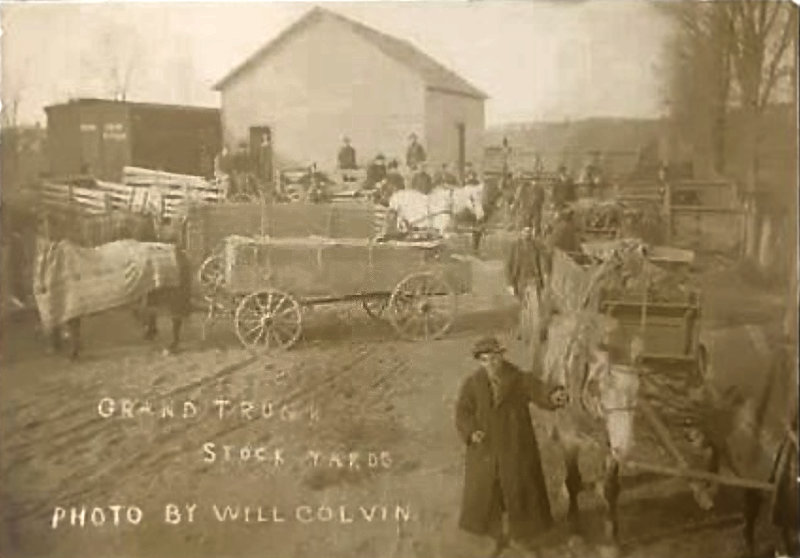
Grand Trunk stock yards--photo by Will Colvin, courtesy of the STHC archives
Several months after the railroad became operational, unexpected news was received: "The Grand Trunk system has acquired another Michigan road in the Toledo, Saginaw & Muskegon railroad," as the Grand Rapids Weekly Leader printed the details in their 8 Aug 1888 issue. Although the deal wasn't an outright purchase of the T S & M, Grand Trunk Railway, which was a Canadian company, took control of operations to compliment a planned new line of steamers between Muskegon and Milwaukee as they expanded their operations. The agreement amounted to a lease arrangement which enabled the original investor group to avoid default and pay creditors. Eventually, in 1928, the purchase of the railroad by Grand Trunk Western was completed.
The Sparta depot, located at the north end of Mill Street--now North Union--was built by the Toledo, Saginaw & Muskegon Railway in 1888, as "one of six constructed that year on the line between Muskegon and Ashley. The depot typifies country "combination-type" depots it sheltered passengers, the station agent/telegrapher, and freight," per its Michigan Historical Site plaque. "The building was vacated in the 1940s."
Train stops along the original Toledo, Saginaw & Muskegon line running from east to west included: Ashley, Ola, Pompeii, Middleton, Carson City, Vickeryville, Butternut, Sheridan, Millers, Greenville, Lincoln Lake, Harvard, Evans, Sheffield, Cedar Springs, Reeds, Sparta, Gooding/Lisbon, Harrisburg, Slocum, Moorland, and Muskegon. Many were once bustling burgs, but like the abandoned railroad line itself are now ghost towns.
Saxon Tower
The Toledo, Saginaw & Muskegon railroad constructed a tower at the intersection of the east-west and the north-south tracks on the north east corner of the village to ensure the safety of trains traversing the intersection of tracks. "I Remember," wrote Arzie Pinckney in his January 1965 local newspaper column, "...a building about fourteen or fifteen feet square and housed the controls of the crossing and the semaphore signals. It required an expert telegraph operator to handle the job. The railroads did not use the telephone so all instructions were sent over the telegraph. Most stations produced their own electric power to operate the equipment by setting up jars with copper plates in blue vitrol and other ingredients. Until the Grand Trunk stopped running trains nights, it was necessary to have an operator on duty 24 hours a day."
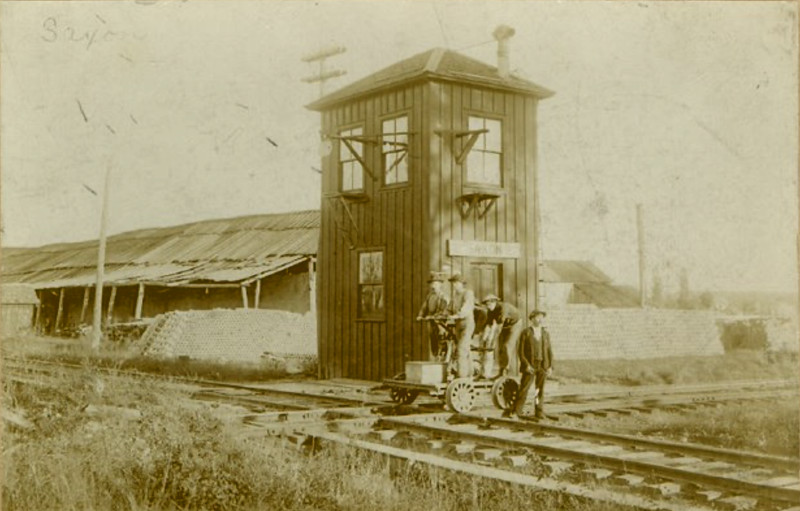
Saxon tower built in 1888 by the Toledo, Saginaw & Muskegon railway at Sparta--photo courtesy of the STHC archives
"The way that the crossing was first made was by cutting out a piece of each rail about a foot long. One of these was placed on a sort of turn table and was operated by levers in the building on the upper floor which was about twelve feet above the ground. To set the rail for the north or south-bound trains, the levers were pulled back. To set them for the east and west trains they were moved forward."
"A lot of Sparta boys learned to be expert telegraph operators and went on to good jobs with the railroad Claude Barkman, Charlie Kinsman and Robert Barry to name a few," recalled Mr. Pinckney. "Robert joined the army after the war in the Philippines was over and was chief telegraph operator in the signal corps in Manilla for two years."
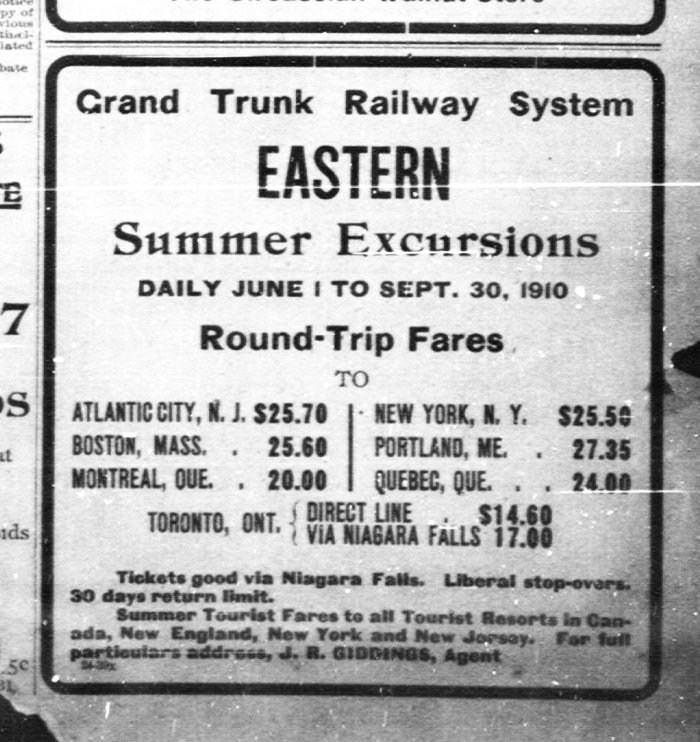
Ad published in the Sentinel-Leader (1910)
"For years the C & O Railroad was called the C & W M (Chicago and Western Michigan). It was changed to the Pere Marquette, then to the C & O (Chesapeake and Ohio). The Grand Trunk was first called the T S & M (Toledo, Saginaw and Muskegon) but most everyone had a nickname for it. Among them was "Tea, Sugar and Molasses", "Too Slow to Mention", "Vinegar Valley Line" and "Tough, Slow and Miserable."
"There were a lot of stories about it also. Some said that when they laid out the track, that if they came to a stump they built the track around it rather than blow it out and fill up the hole. Or they said that the road was so crooked that they had to put hinges on the boiler and burn crooked cord wood so the engine wouldn't jump the track. I do know that some of the curves were so sharp that the conductor on the freight train could signal to the engineer from the caboose."
"There was a time when there were passenger and freight trains both ways every day on the line, but when it was discontinued, there were only a few freight cars and one passenger car each way a day. So Sparta witnessed the death of what was once a busy railroad."
In a May 23, 1946, Sentinel Leader article it was announced Sparta's Grand Trunk Railroad station would be closed "After serving the people of Sparta and vicinity for more than half a century."
Sparta's Trolley
The Holland & Lake Michigan Company built an electric road within the city, to Lake Michigan, and south to Saugatuck. On the Fourth of July, 1899, they announced in the Grand Rapids Herald it would be extended to Grand Rapids. Completed, it became a rewarding venture and was known as the Interurban.
Electricity arrived at Sparta, once Jacob L. Hisey secured the ten-year contract to provide the utility. With the installation of a Hugh's duplex steam pump (10"x6"x12") at the Sparta Milling Company, he supplied power for city mains.
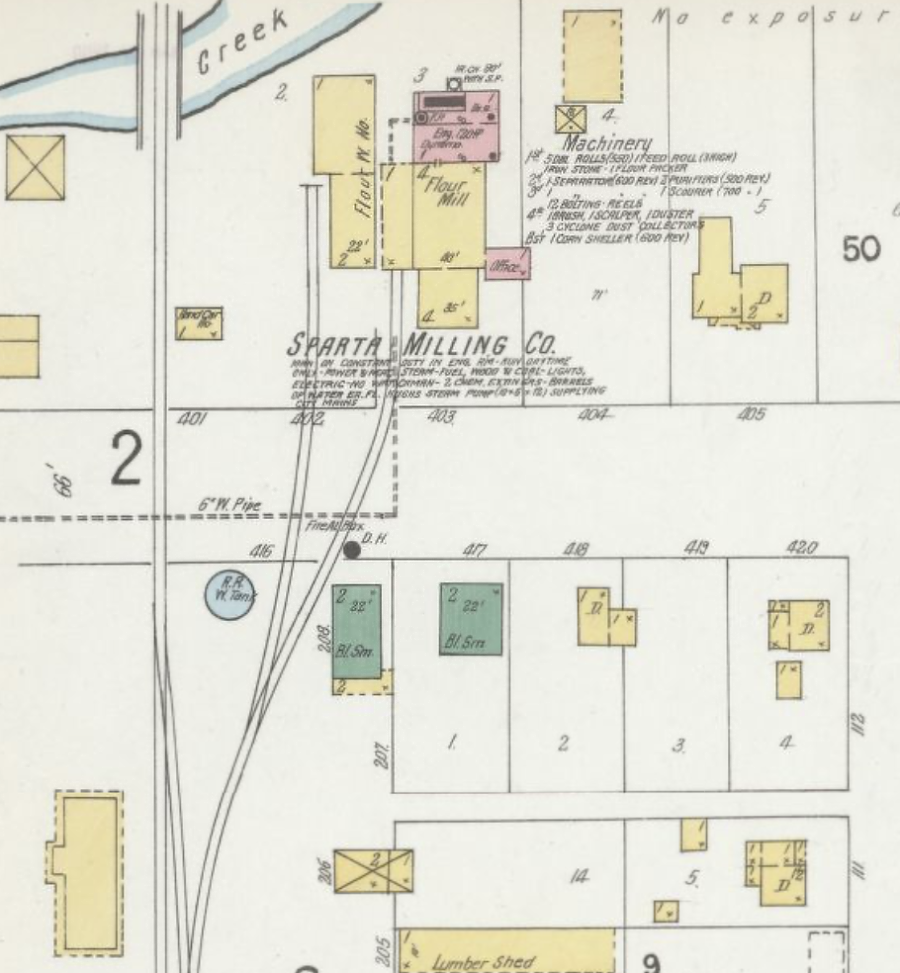
The Sparta Milling Co. located on Division Street, just east of the railroad, appeared in an 1899 map prepared by the Sanborn Fire Insurance Company which described the equipment used to make electricity, the train depot is located at the lower left corner; courtesy of the Library of Congress.
In 1899, Hisey and a Village council committee determined the placement of electric lights throughout the municipality. His cost estimate was, as published in the Sentinel, "...but a little above the cost of oil, which makes it cheaper than oil lighting, since the work of lighting and extinguishing as well as caring for lamps will be saved." Satisfied, the council approved the project and it was declared: "Work on the electric light system is to be begun immediately and will be in full operation within 30 days."
The Village of Sparta entered into an agreement via an "Ordinance granting to Jacob L. Hisey, his heirs or assigns, and to any company succeeding to his rights thereunder, the right to lay, construct, maintain, use and operate a street railway in the Village of Sparta..." the Sentinel Leader declared on January 31st of 1901, as they published the entire document. The motor power for the trolley had to be electricity, or another form of power approved by the Village board of trustees, but could not include either steam or animal power. It would begin at "Main street (now State Street) and Centennial avenue running north to Division street west to the west side of the cemetery and east to the Pere Marquette railway, then beginning at Division and running north on Mill street (now Union) to the Toledo, Saginaw & Muskegon railway depot."
Section 7 required "first class" cars which would be "warmed during winter months". Section 9 specified the "said railway shall employ none but sober men, careful and prudent agents, conductors, and motormen to take charge of the cars while on the road, and conductors shall not allow ladies or children to enter or leave and car while said car is in motion."
Apparently Mr. Hisey had plans to connect his trolley to that of Grand Rapids and Section 11 stated he could charge no more than 20 cents per person for a one way ticket to the city or thirty-five cents for a round trip. Rates to anywhere within five miles of Sparta or inside the Village limits were capped at five cents.
How fast could the trolley go? On Division between Main and the railroad station on the east side and also going north on Mill streets the speed limit was set at eight miles per hour, while on other Village streets, twelve miles per hour was allowed.
Jacob L. Hisey, Sparta Village Clerk Wakefield Haines, and President Wallace Burtch signed the contract. By May, the Sentinel-Leader printed the news stating: "A franchise has been granted J. L. Hisey for the electric road through Sparta township."
Another item in the same newspaper read: "The Grand Rapids, Sparta & Newaygo electric line will in many cases be obliged to secure land of the farmers over which to run. This work is now under way. James Townsend of New York is now managing the financial end of the deal. The prospects of the road are brighter than any in Michigan. The territory traversed by the proposed line is prolific and a big business can be secured. Cheap power from the Croton dams will be another thing in favor of the road. The road will be completed some time next year and possibly sooner. Real estate will probably go up a notch when the cars begin to run."
For whatever reason Mr. Hisey was unable to start work on the trolley within the allotted 30 day time frame so the opportunity was null and void.

Jackson & Hisey's Sparta Milling Company as it appeared after Mr. Hisey established electricity service for the village
Jacob Lehman Hisey
Jacob was born in October 1867 at Semford, Ontario, Canada, the son of Elias and Martha (Lehman) Hisey. He removed to Sparta in 1881 with his parents and on 27 Jun 1894, he married Pauline Lena Jackson, the daughter of Charles Harrison and Elizabeth McPherson (Quigley) Jackson. The Jacksons immigrated from Canada in 1877 to Montague in Muskegon County, Michigan and later settled at Sparta, where Charles Jackson purchased the Sparta Milling Co. grist mill. Jacob became his partner. Their business listing in Polks' Gazetteer stated their Jackson & Hisey mill was the "Mfg of Patent, White Lilly, Our Best and Royal, and Dealers in Hay and Grain."
In May of 1895, a son, Paul Jackson Hisey, was born. The Federal Census of 1900 stated Jacob was a widow, employed "grist milling", while he and his son resided with his father-in-law. Jacob married Aleta Matilda Pintler, a school teacher, on 22 Aug 1900 at Lisbon, in Ottawa County, Michigan. The bride was the daughter of Curtis and Carrie M (Smith) Pintler, of nearby Chester.
After the opportunity to build a trolley car company at Sparta fell through, they moved to Muskegon as he became the treasurer and manager of the Muskegon Milling Company where his father, Elias, was the miller. Meanwhile, The Weekly Modern Miller reported in November of 1900 that "J.L. Hisey has sold his interest in the Sparta Milling Company, Sparta, Mich. to C.H. Jackson, who will continue the business. The electric lighting plant is included in the deal." By 1911, Mr. Jackson brought in a partner, Harry Brace, and hired two new millers.
Jacob and his wife had two additional children, Lyman and Virginia, and by 1910, had relocated to Los Angeles, California where he gave the census enumerator his occupation as "retired".
Charles Jackson continued to operate the mill and provided a home for his grandson, Paul, while he attended Sparta schools. After he graduated, Paul rejoined his father in California. By 1920, the family, with the addition of son Wilbur, resided at West 7th Street in Los Angeles, and Jacob had become a wholesale grocery merchant.
Contact
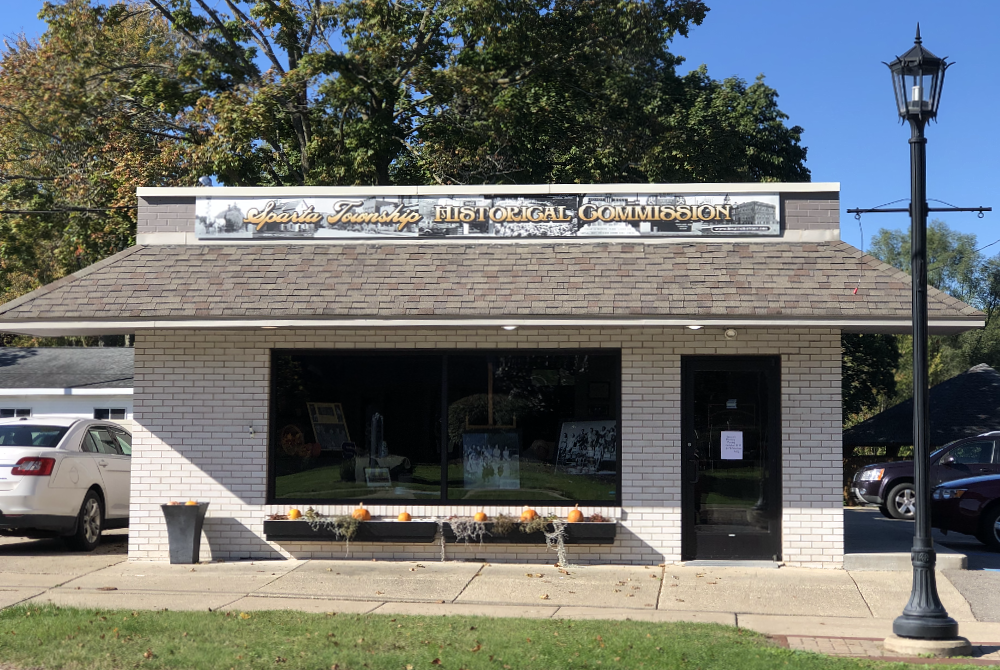
Sparta Township Historical Commission headquarters at 71 North Union Street
Our History Center is conveniently located at 71 North Union Street in downtown Sparta. Please join us for coffee and lively conversation on Monday mornings. Visits to the History Center can also be scheduled by appointment, for your convenience.
We do not receive mail at the History Center, instead, please use our mailing address, which is:
attn: Sparta Township Historical Commission
Sparta Township
160 E. Division St.
Sparta MI 49345
Our complete archives are now available online for your convenience. Just click STHC PastPerfect Catalog Access and begin your research!
For other inquiries, the Sparta Township Historical Commission can be reached by phone at (616)606-0765 or via email at the following address:
Our meeting minutes are available on the Sparta Township website.
